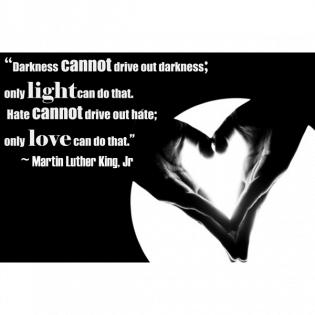Reaching to the Clouds for Equality
Children reflect on Martin Luther King, Jr.’s dream and how he used his words. They reflect on their own dreams for a better community.
The learner will:
- express their own dream for the world modeled after Dr. King.
- read-aloud copy of Martin’s Big Words by Doreen Rappaport
- white construction paper, two sheets per child
- cloud pattern for tracing (approx. dimensions: 8" x 11")
- newspaper to stuff the clouds
- stapler
- fishing line, if hanging the clouds from the ceiling
For homework, children ask their families about their dreams and how they are working toward achieving them.
- Rappaport, Doreen. Martin’s Big Words. Jump at the Sun, Inc., 2001. ISBN 0786807148.
Instructions
Anticipatory Set:
Ask the children what big words are used for. Before reading, say, "I wonder what big words the author thought were so important that she put it in the title?" Read the book Martin’s Big Words by Doreen Rappaport. Stop periodically to talk about the big words and check for understanding.
After reading, ask some of the following: How did Martin Luther King, Jr. use big words? What was Martin Luther King Jr.’s dream? How did he "fight" for his dream? How can we keep this dream alive today? How should we respond when we see some unfair treatment? How was MLK a philanthropist? (A philanthropist gives time, talent or treasure for the common good.)
Guide the children to trace and cut out two cloud shapes. They staple the two clouds together but leave an opening for stuffing with newspaper. They write "I Have a Dream" on one side of the cloud shape. On the other side, they draw a picture and write a sentence about their dream for a better world.
Stuff with one sheet of newspaper to give the cloud a 3-D look. Finish stapling the cloud closed. Hang the clouds from the ceiling.
Philanthropy Framework
-
Strand PHIL.I Definitions of Philanthropy
-
Standard DP 02. Roles of Government, Business, and Philanthropy
-
Benchmark E.6 Explain why acting philanthropically is good for the community, state, nation, or world.
-
-
Standard DP 04. Operational Characteristics of Nonprofit Organizations
-
Benchmark E.1 Describe how citizens organize in response to a need.
-
-
-
Strand PHIL.II Philanthropy and Civil Society
-
Standard PCS 01. Self, citizenship, and society
-
Benchmark E.3 Describe a benefit of group cooperation.
-
-
Standard PCS 02. Diverse Cultures
-
Benchmark E.5 Identify the relationship between individual rights and community responsibility.
-
-
Standard PCS 05. Philanthropy and Government
-
Benchmark E.10 Give an example of an action by an individual or a private organization that has helped to enhance a fundamental democratic principle.
-
-
-
Strand PHIL.III Philanthropy and the Individual
-
Standard PI 01. Reasons for Individual Philanthropy
-
Benchmark E.4 Give an example of how citizens act for the common good.
-
Benchmark E.5 Give examples of actions students can take to improve the common good and list or describe responsibilities that go with those actions.
-
-
